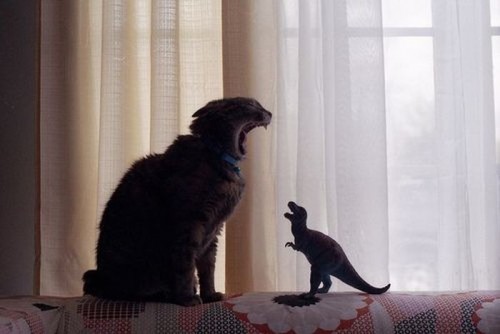British Scientists Clone a Dino -- NOT
The news: A story from hoax site News-Hound claiming that British scientists from Liverpool's John Moore University have successfully cloned an Apatosaurus is getting a lot of traction on the Internet this weekend. But ... no, they haven't.
From the article:
The dinosaur, a baby Apatosaurus nicknamed "Spot," is currently being incubated at the University's College of Veterinary Medicine.
The scientists extracted DNA from preserved Apatosaurus fossils, which were on display at the university's museum of natural science. Once the DNA was harvested, scientists injected it into a fertile ostrich womb.
"Ostriches share a lot of genetic traits with dinosaurs," said Dr. Gerrard Jones, a biology professor at LJMU and the project's leading scientist. "Their eggshell microstructures are almost identical to those of the Apatosaurus. That's why the cloning worked so perfectly."
Those in the scientific community say the dinosaur cloning – the first ever of its kind – is a milestone for genetic engineering.
"I used to think this kind of thing could only happen in the movies," said Dr. Gemma Sheridan, a LJMU chemistry professor. "But we're making it happen right here in our lab. It's astounding."
Yeah ... no. Never mind the lack of sources, links or the various ludicrous stories lining News-Hound's sidebar (the name Gemma Sheridan, for example, was used in a previous hoax claiming Google Earth found a woman trapped on an island for seven years). Or that it would take approximately 10 seconds to verify that the photo of a "dinosaur" baby is actually a newborn, furless macropod (a kangaroo or wallaby).
Read the full spoiler article here
Sunday, March 30, 2014
Sunday, March 9, 2014
Euro Trasher
Biggest predator ever to stalk Europe: 4-inch teeth and 33 feet long
At about 33 feet long, weighing 4 to 5 tons and baring large blade-shaped teeth, the dinosaur Torvosaurus gurneyi was a formidable creature.
"I suppose it wouldn't be
a good idea to cross the way of this dinosaur," said Christophe
Hendrickx, doctoral candidate at the New University of Lisbon in
Portugal.
Thanks to Hendrickx and
paleontologist Octavio Mateus, Torvosaurus gurneyi may have the
distinction of being the largest terrestrial predator found in Europe.
Hendrickx and Mateus describe this dinosaur in a new study in the
journal PLOS One.
Tuesday, March 4, 2014
Untangling multiple fauna millions of years apart at the same site
Newly identified dinosaur fauna sheds light on evolution
It’s not a surprise that researchers originally assumed that everything that was turning up was effectively part of the same series of fossil beds. After all, such things were extraordinarily rare, and basically everything was preserved in volcanic ash. What were the odds that this was more than one fauna that just happened to overlap exactly geographically and in preservation type? The fact that many of the early discoveries were made by farmers or came through fossil dealers added to the confusion. Without knowing the exact origins of the material it was impossible to correlate the various fossil beds and outcrops that spread from the Chinese region of Inner Mongolia though the province of Liaoning and even into North Korea
However, in recent years it has become increasingly apparent that some of the material was rather older than had previously been thought. The new paper (of which I am an author) reviews the evidence establishing the geological age of these older fossils, and more importantly, suggests that they can be considered part of a new fauna. These older specimens come from a number of different localities, but they can be linked together by the presence of a salamander species. Radiometric dating work for numerous sites confirms an age of around 160m years old. We can thus use this species as a marker to help define what does and does not fall into this fauna and the dating suggests the existence of these animals over a relatively limited period of geological time.
Read the article here
It’s not a surprise that researchers originally assumed that everything that was turning up was effectively part of the same series of fossil beds. After all, such things were extraordinarily rare, and basically everything was preserved in volcanic ash. What were the odds that this was more than one fauna that just happened to overlap exactly geographically and in preservation type? The fact that many of the early discoveries were made by farmers or came through fossil dealers added to the confusion. Without knowing the exact origins of the material it was impossible to correlate the various fossil beds and outcrops that spread from the Chinese region of Inner Mongolia though the province of Liaoning and even into North Korea
However, in recent years it has become increasingly apparent that some of the material was rather older than had previously been thought. The new paper (of which I am an author) reviews the evidence establishing the geological age of these older fossils, and more importantly, suggests that they can be considered part of a new fauna. These older specimens come from a number of different localities, but they can be linked together by the presence of a salamander species. Radiometric dating work for numerous sites confirms an age of around 160m years old. We can thus use this species as a marker to help define what does and does not fall into this fauna and the dating suggests the existence of these animals over a relatively limited period of geological time.
Read the article here
Monday, March 3, 2014
Subscribe to:
Comments (Atom)



